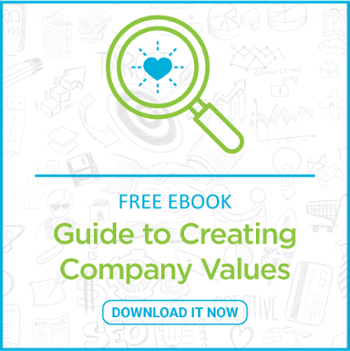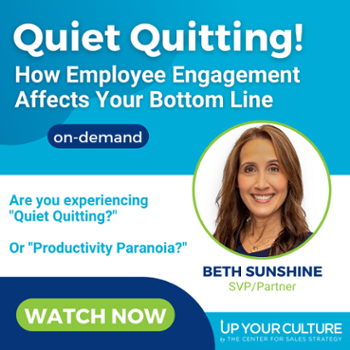.jpg?width=1920&height=1080&name=CoC__Ep9_Cover%20Graphic%20(1).jpg) In this episode, we’re tackling how to go about mastering the art of individualized management. How can leaders best harness the unique talents and powers of each individual to maximize engagement across their teams?
In this episode, we’re tackling how to go about mastering the art of individualized management. How can leaders best harness the unique talents and powers of each individual to maximize engagement across their teams?
Joining Beth to break it all down is a master of individualized management herself, Sarah Dobbins, Market President and Chief Revenue Officer at Townsquare Media Portland and August, Maine.
Sarah has so many valuable insights to share, such as:
- How understanding talents at an individual level can make it easy to be the perfect “matchmaker” for clients and account executives
- Why talking about individual talents can really feel like a “love language”
- And, finally, how consistently using Growth Guides makes it that much easier to put words into action.
Knowing an Individual’s Talents Can Make You a Great “Matchmaker”
“Many organizations use talent assessments in the hiring process just to make sure that they're bringing people on board where they can excel,” Beth says, kicking off the conversation.
“But I also know that those assessments can be just as powerful for coaching. And that's what I want to dig into. So, my first question for you is, what has your experience been with coaching individuals based on their innate talents?”
“So, Beth, it's a great question and we've had a great experience with [talent assessments],” Sarah says. “And we use them in several different ways. I thought I'd share two today that could be helpful for people.
“One is kind-of fun. It can be used as a matchmaker for clients and Account Executives (AE’s). So, [this is] identifying what is most important to the client and then matching them up with the right AE and their superpower strengths. That starts that relationship off strongly knowing that you've put together two people based on what the client's looking for. And then you're soaring with the AE’s strengths."
 “For example, if you talk to a client and you know they look for somebody to be super organized, really detailed, solution-oriented, and they want someone to really understand their products, etc. That's a really great place to start because then, with the talent themes and the top talent report, you can go back to an AE and identify who's the best fit for that [client]. So, in that situation, I'd be looking for somebody with discipline, an activator, an individualizer. And when I find that in the AE and I've matched it with the client, I know right away that we've got a recipe for success."
“For example, if you talk to a client and you know they look for somebody to be super organized, really detailed, solution-oriented, and they want someone to really understand their products, etc. That's a really great place to start because then, with the talent themes and the top talent report, you can go back to an AE and identify who's the best fit for that [client]. So, in that situation, I'd be looking for somebody with discipline, an activator, an individualizer. And when I find that in the AE and I've matched it with the client, I know right away that we've got a recipe for success."
“The other way that we use it...is positive problem-solving. Problem-solving can be a little bit stressful. And so, if you can make it positive and people can learn from it, it's a great tool."
“You know, you’ve got to think about it, by the time an employee has come to my desk or come to see me with a problem, they've probably tried to solve it on their own. And so they're probably a little stressed out about it. When you're taking somebody's talents and helping them solve that, it kind of diffuses the situation and makes it less stressful for them."
“A quick example of what I mean by that, to kind of help guide the conversation, is, we have some employees on the staff that have super high positivity and relationship, but they might be a little bit lower in discipline and that's okay because they fit the makeup of the team. But you can get ahead of that with that particular AE by having them really lean into that positivity and really lean into that relationship, and ask them questions like, “If we don't meet this deadline, how is that going to make that client feel? Or how are you going to make that person feel if you don't do what you say that you're going to do?’"
 “So, it's really kind of pulling forward their really strong talents to help them overcompensate for something that might not be as strong of a talent for them. It has helped us change the conversation to keep things more positive, um, in the sales conversations.”
“So, it's really kind of pulling forward their really strong talents to help them overcompensate for something that might not be as strong of a talent for them. It has helped us change the conversation to keep things more positive, um, in the sales conversations.”
“I love that,” Beth says. “I'm really hearing that you're kind of speaking their language.”
“So, with how you might be talking about a potentially missed deadline with a client. You could do that with any of your people, but you are choosing what language to speak based on how they're wired.”
“It's a love language, right?” Sarah says. “It's who they are, what makes them really great, and why you hired them. You definitely hired them for their top talents, so why not use them in every situation that you possibly can?
“So here we focus a lot on mindset and a positive mindset. And focusing on an employee's talent really creates and continues to focus on that positive mindset because it allows for just positive conversations.”
“Even if you're solving a problem as I shared before, you can solve it by working with an employee's talents or strengths. It just changes the conversation every single time.”
Growth Guides Transform Words into Action
“We all are motivated differently,” Beth says. “We have different work styles, different personalities, and different interests beyond what you learn from a talent assessment. Beyond talent assessments, how have you been able to better understand each individual you manage and recognize what they may need from you to be successful?”
“You’ve got to get outside of the office and really catch up with somebody outside of the normal questions,” Sarah says.
“We really want to understand who your employees are outside of the office walls because what happens at home also influences what happens at the workplace. If they share something that's important to them, lean in and remember it. Listening to that is super important."
“As an example, if somebody here knows that if they're going to run a marathon or they're doing something with a charity and they're participating in something, they'll come to see me. We'll host a bake sale, everyone will bring in baked goodies, and then we'll sell the baked goodies to the staff and then all that money raised will go towards that person's charity or whatever they’re participating in."
“You know, another thing that we use that is something that you guys provide and has been really beneficial to that is the Growth Guide. We talk a lot about people having their best year yet, both personally and professionally, but actions do speak louder than words. So, I can say that, but if my actions aren't doing that, then it's just words."
“The Growth Guide really puts it into action. Because in that time period, you're really listening to your employee on what they want and how they're going to grow and how you're going be able to help them do that. Once you've done the Growth Guide, it's super important to follow up with them and make sure that [you both are] owning what you guys had talked about for them to grow."
“There's something I keep seeing on LinkedIn and it's really resonated with me. It's something along the lines of like, ‘A salary increase makes you happy once a year, but a healthy workplace keeps you happy throughout the year.’ To me, as leaders, it is our responsibility to create a workplace that makes our people happy and thriving."
“That starts by really leaning in and listening to them and asking questions that aren't just about hitting budgets or when you're going to get that CNA (Customer Needs Assessment) or when that order's going come through. You have to understand who they are as a person and care. It's really important.”
Give Your Employees the Opportunity to Test Their Leadership Skills
“I'm hearing ‘transparency’ from you,” Beth says. “I'm hearing that you're not the puppet master behind the scenes, moving the puppet's hands and mouths. You are, to a certain extent, influencing their actions because you know how they're wired. But you're telling them, ‘You've got strength in this area, so here's why I'm doing this.' Are there any other best practices you would share with others related to individualized management?”
 “We talked about the Growth Guide,” Sarah says. “I would make sure that you're doing those with your AEs or your employees at least once a year. Make sure that they want to be where they're at and that they have goals and that you're helping them get to that particular goal."
“We talked about the Growth Guide,” Sarah says. “I would make sure that you're doing those with your AEs or your employees at least once a year. Make sure that they want to be where they're at and that they have goals and that you're helping them get to that particular goal."
“There's nothing more exciting than for someone who works for me to come running in and share something that they did to help achieve something that we talked about in the Growth Guide."
"And I also think about some AEs who have wanted to get into leadership. So, we put them in leadership roles inside of the building. Maybe they're running a sales meeting, maybe we're putting them in some sort of leadership training. But once we know that that's what they really want to do, we help guide them in the direction to get there. Because it also gives them a taste of it too."
“Like, ‘Is this something that you really want to do? Let's try it and make sure that it is something that you like and that you want to continue to succeed in that.'"
“So, I would just say make sure you're setting people up to succeed all the time. And those Growth Guides allow that mutual commitment to each other and to the success of that individual person.”
To wrap up the conversation, Beth asks the final question, “If you could wave a magic wand and make one thing easier to accomplish or make it better when it comes to managing people, what would that be?”
“You know, it's such a great question and it's one that I've been noodling,” Sarah says. “And I keep kind of going back and forth on a couple of different things. You know, I try to lead with people's talent, so maybe not every training is suitable for somebody. Maybe I need to look at doing it differently by taking people's talents and putting them in trainings. That would help ‘super serve’ those people.”


.jpg)








Leave a Comment